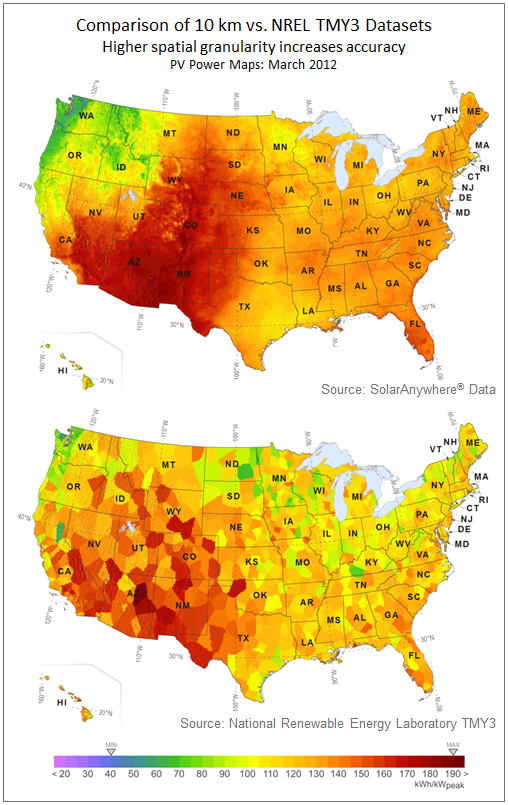In keeping with our mission of powering intelligent energy decisions, Clean Power Research is introducing a 10 km Typical Meteorological Year (TMY) dataset for use in Clean Power Research API services. Programmatic access to this high-resolution dataset and the PVWatts simulation engine will allow residential and commercial solar providers to improve their long-term production estimates. As a result, they’ll be able to generate more competitive proposals, maximize sales, and help ensure that performance guarantees are met in future years.
While continuing to receive the high-availability they’ve come to trust, Clean Power Research API users will now have the flexibility to select the power simulation and datasets they prefer. This includes the PVWatts energy production engine and NREL’s National Solar Radiation Database (NSRDB) TMY 10 km dataset, as well as the Clean Power Research PV simulator and NREL TMY3 irradiance datasets.
The fundamental input into the NSRDB TMY 10 km dataset is SolarAnywhere® Data, a satellite-derived dataset that incorporates the latest Perez satellite model. The use of satellite-derived irradiance data provides several advantages over ground-based measurements—the primary input for TMY3— including:
- High spatial granularity—the NSRDB and SolarAnywhere datasets are comprised of approximately 100,000 data points across the U.S. Compare this to the TMY3 dataset, which is produced from 1,454 locations to represent the entire U.S. The maps below show how this difference in granularity looks across the U.S. Because accuracy decreases as the distance from the data collection points increases, high granularity enables more accurate power estimations. This is especially important in micro-climates.
- Consistent measurement source—all inputs into the satellite-based irradiance model are taken from an image that covers a large geographic area. This means that sites can be reliably compared regardless of distance.
- Complete data records—data is collected continuously with negligible downtime via satellites that are operated by the U.S. government (NOAA). As a result, satellite dataset gaps amount to a fraction of one percent of the hours recorded in SolarAnywhere. By comparison, NREL states that only 860 out of 1,454 weather stations have serially complete data records.
For more information about the NSRDB dataset, see NREL’s National Solar Radiation Database 1991-2010 Update: User’s Manual, or the blog post “NREL turns to SolarAnywhere for NSRDB.”
To get started using Clean Power Research API services today, please Contact Us.

